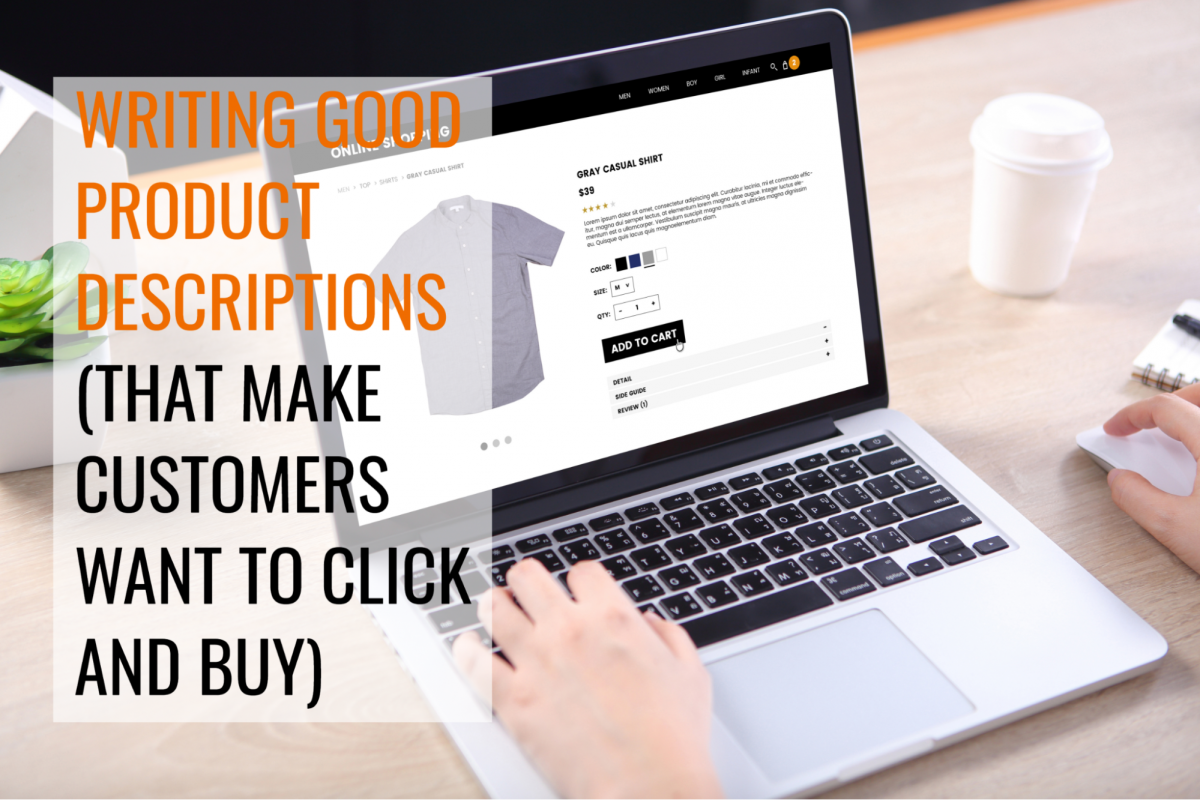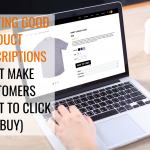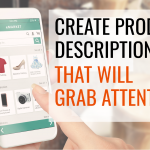Want to improve your ecommerce store’s conversion rate?
Try writing better product descriptions.
The Good states that optimizing product descriptions is one of the “highest-return, lowest-investment improvements an ecommerce manager can make.” In fact, they also state that some 87 percent of consumers rate product descriptions as extremely or very important when deciding to buy.
Product descriptions are vital for any online store, where people don’t have the benefit of being able to see the products in-person, and are often what will make or break whether someone goes through with their purchase.
Creating good product descriptions, though, isn’t always easy.
When selling online, you need to be able to give visitors all the relevant information they need about a product, while making sure they’re not bored to death with too much detail or unnecessary words. On the other hand, you don’t want too little information. Insufficient product details can turn away potential buyers and lead to cart abandonment, according to Baymard.
So how can you convince people to buy your product, just through words and images? Let’s find out now.
(Source: The Good)
Checklist for Writing Product Descriptions
It’s easier to write effective marketing copy when you know your audience. Taking time to plan and strategize gives you clarity and narrows down what you need to say. Here are some useful questions you should think about before starting:
- Who is your customer?
- What are their pain points and why do they need this product?
- What are their expectations from the product?
- Where and how can they use it?
- What details are needed to prove the quality of the product?
- What additional information will be useful?
- What makes the product unique from the competitors?
- What are possible objections that will be raised?
- What tone should you use?
Pro Tip: To streamline your work and save time, create a product description template that you can use for reference in the future.
Tips for Writing Excellent Product Descriptions
Ready to start writing product descriptions that convert? Here are some tips that’ll help you to get started.
For Basic Products: Keep It Simple
For basic products that are self-explanatory or things that could be categorized as impulse buys, it’s usually best to use clear, simple descriptions. There’s no need for long and fancy details, which could confuse visitors and make them click away.
Take this example from Mrs. Meyer’s Clean Day. The product title is straightforward and you immediately know what it’s for. The wording on the details section is simple and manages to highlight key features that matter to their target customer: “quick, easy, and safe to use, cruelty-free, with an original and clean scent.”
(Source: Mrs. Meyer’s Clean Day)
For More Technical or Complicated Products: Clear Up Doubts or Confusion
If you’re selling something unique, innovative, or entirely new to the market, make sure your product descriptions clearly explain what it is and how to use it. There’s nothing worse than having a prospect look away just because they didn’t understand what the product does.
A good example is the product description of this C02 bike pump from Genuine Innovations. This isn’t your standard bike pump and looks like it could be a can of spray paint. However, the product title quickly dispels any doubt and states exactly what it is: a bicycle C02 inflator.
In the “About this Item” section, you can also see how the manufacturer highlights “ease of use” several times. This assures the customer that even though it’s an unfamiliar device, using it isn’t complicated.
(Source: Genuine Innovations)
Speak Your Customer’s Language
I’ve talked about how buyer personas and customer avatars are extremely important when you’re launching a business, a new product, or entering a new market. They also come in handy for writing good product descriptions. With a clearly defined buyer persona, you can talk in a voice your customers can relate to and easily capture their interest.
People don’t like being sold to, so avoid copy that’s flat and sales-y. Use a friendly, conversational tone, which is more authentic and approachable.
Copywriting expert Henneke Duistermaat has great advice: “Consider how you would speak to your ideal buyer if you were selling your product in store, face-to-face. Now try and incorporate that language into your ecommerce site so you can have a similar conversation online that resonates more deeply.”
Check out this product copy from Quest Nutrition. They use a conversational, helpful tone, something you might hear from a group of friends talking.
(Source: Quest Nutrition)
Include Details to Build Credibility
Make sure you include the necessary details and information that people need to make a purchase. This usually includes:
- Product specs: Including materials or ingredients. The size, weight, and dimensions should also be included.
- Instructions and care information
- Size chart (when relevant)
- Warnings and allergens (when relevant)
- Shipping information
- Warranty information
- Other FAQs
- And more!
For gadgets, it’s especially important to include product specs, like this one:
(Source: Cool Blue)
Translate Product Features Into Customer Benefits
In your product copy, your customer should always be the star, and your product the solution. A mistake that sellers often make is going on about technical details and features without saying why these should matter to the customers. Put yourself in your target audience’s shoes and see how your product’s features can improve their lives. Translate features into benefits and use your product description to tell the story.
Check out this product description on my website, Vet Naturals. Instead of just listing the ingredients, we take things a step further and outline exactly what the different ingredients can do for your dog.
(Source: Vet Naturals)
This product page from BBQ Butler also has a great example of product features and customer benefits:
(Source: BBQ Butler)
Show (Don’t Tell). Create an Experience
Shopping in-person is exciting because of the sensory experience: seeing and holding something, trying out product testers or samples. It’s easier for customers to imagine how something will fit in their life or home. Touching an item has also been shown to increase the likelihood of purchase.
You might be asking how online sellers can benefit from this when you can’t feel a product on the internet. The answer: create an experience in your visitors’ minds with words and images. Appeal to their senses. Tell a story, make your customers dream and imagine all of the good stuff that’s waiting for them if they purchase your product.
See this example from Brooklinen, which uses a combination of words and images to sell an experience. The term “super-plush” on the product title appeals to the sense of touch. Below the fold, there’s “ridiculously soft,” “luxurious,” and “perfect for turning your bathroom into a dream spa.” On the bullet details, there’s “extra thick for spa-like comfort.”
Scroll further and you’ll see a good example of translating features into benefits. If you’re still not convinced, there’s another line at the end saying, “A spa retreat at home.” They also included a photo of how your at-home spa treatment could look. Judging from the 1,502 reviews, their product descriptions managed to convince customers that their towels create an “at-home spa experience.”
(Source: Brooklinen)
Show Your Product as a Solution to an Anticipated Problem
People mainly shop for two reasons: to move towards pleasure or to move away from pain. You have to show how your product bridges the gap between where your customer is and what they want to be. Show people how your product can improve their condition or situation, and you’ll have higher chances of sales.
Take a look at mattress company Saatva. They promise: “Pure comfort without the markups- Discover pure sleep bliss, at prices that won’t keep you up at night.” It addresses the customer’s need for better sleep, at an affordable price. On the “Overview” tab they talk about solving pain points such as poor sleep posture and temperature regulation.
Get our Creating Great Product Descriptions delivered right to your inbox.
(Source: Saatva)
Lighten Up the Vibe: Inject Some Humor in Your Descriptions
A touch of humor adds another “human” touch to your marketing. If done right, it helps you create a positive customer experience and makes you stand out from your competitors. Find out what type of humor your ideal buyer appreciates and the words and expressions they use. Be careful not to insult anyone, and match your language with your customer base and brand tone.
Check out this one from Click and Grow:
(Source: Click and Grow)
Now, take a look at some of Dr. Squatch’s product descriptions. Their soaps feature some winning product descriptions that are fun, descriptive, and engaging. They solve a problem, for sure, and have fun doing it. Take a look:
“Turn your shower into cocktail hour with the intoxicating scent of Wood Barrel Bourbon. A refined blend with aromas of patchouli, clove and guaiac wood will transport you to your man cave with your favorite drink in hand. Taking a tip from distillers, we combine exfoliating Jimmy Red Corn, known for making the best bourbon, with soothing Brewer’s Yeast to craft this perfect barrel-aged brew.”
It addresses a problem: getting clean, and speaks to their target audience: men who are probably bored of the same old shower gel and soap.
Be Careful About Using Superlatives
Nobody would describe their product as so-so or average. Often, you’ll see product descriptions calling their items the “best,” “greatest in the world,” or “best in its class.” Unless you can back these claims with specific and legitimate proof, superlatives can sound hype-y and unbelievable. If you don’t have any proof that you can show (yet), consider toning down your copy, or use customer quotes from testimonials or reviews.
Avoid Technical Terminology
We can’t talk about standout product description examples and copywriting without mentioning Apple. Despite always being at the forefront of innovations and new technology, you’ll notice that Apple never uses complicated language to communicate with customers. They’re experts in hooking in people with short, memorable sound bytes.
Fortunately, Cameron Craig, the communications expert who helped transform Apple’s PR strategy, shares some of their copywriting strategies in his article for Harvard Business Review. Craig advocates for simple and clear writing: “Any hint of jargon, cliché, or techno mumbo-jumbo would be removed in the editing process. If a “mere mortal” couldn’t understand our language, then we had failed.”
He adds that if you ran Apple press releases through a readability level test, it would score a grade 4 or lower.
Check out these product descriptions for the iPhone 12 and iMac 24”:
(Source: Apple)
No technical jargon, just a simple description of how the latest features improve your online conversations. For those who are interested in the technology behind it, there’s a “Tech Specs” tab on the product page.
Other online stores use it successfully, too. See this example from Resnap. Short and simple, yet communicates the most important points:
(Source: Resnap)
Pro Tip: Do you want to check how simple your product descriptions read? Run it through the Hemingway Editor, a free app that grades the readability of any piece of writing. To make sure you get the most important points across, edit out words that are redundant, don’t add value, or don’t resonate with your ideal customer.
Power Words and Sensory Language
Power words, in the context of marketing, are words that “elicit strong psychological responses from readers. When used correctly, they can generate interest and increase conversion,” according to Hubspot. Combine it with words that appeal to the senses, and you can increase your chances of conversions.
(Source: Referral Candy)
You can also check out Hubspot’s list of 150 power words that you can use in your copy.
See how this product description example from Apple uses sensory words such as “rich,” “deep,” “incredible,” “massive,” and “detailed” to describe their new speaker.
(Source: Apple)
Format for Readability
Not everybody has the patience to read every single word on a web page, especially if it’s not easily scannable or skimmable. Don’t lose potential buyers. Make your product page format easy to read. Use readability best practices and use subheadings, lists, and bullet points. If lots of details are necessary, break them up into sections or add links, like what Nespresso does here:
(Source: Nespresso)
Optimize Your Copy for SEO and Search Engines
In addition to convincing potential customers to purchase your product, don’t forget to optimize for search results. Product descriptions with relevant keywords can boost your online store’s search engine result ranking, boosting your online presence and chances of getting seen by people who search for products like yours.
Shopify suggests placing keywords in the following sections:
- Page Title
- Meta Descriptions
- ALT Tags
- Product Page Content
Great product descriptions matter. They’re your opportunity to grab a prospect and lead them on to the point of conversion. Good product descriptions are a masterful blend of sales strategies and storytelling. They inform and give details about a product. They’re the marketing tool that takes your ecommerce store from the place where someone is “just looking” to a sale, so it’s worth spending some time to get these right.
So speak your customer’s language. Show them, don’t tell them why they should care about your product, and showcase your product as the solution to their problems. Connect with them, and use humor when you can. Then start creating your descriptions; the kind that make your customers want to click and buy.
Ready to grow your company? Reach out now for your FREE 20-minute consultation call. Let’s find solutions that will help you scale your ecommerce business today.
Get our Creating Great Product Descriptions delivered right to your inbox.







